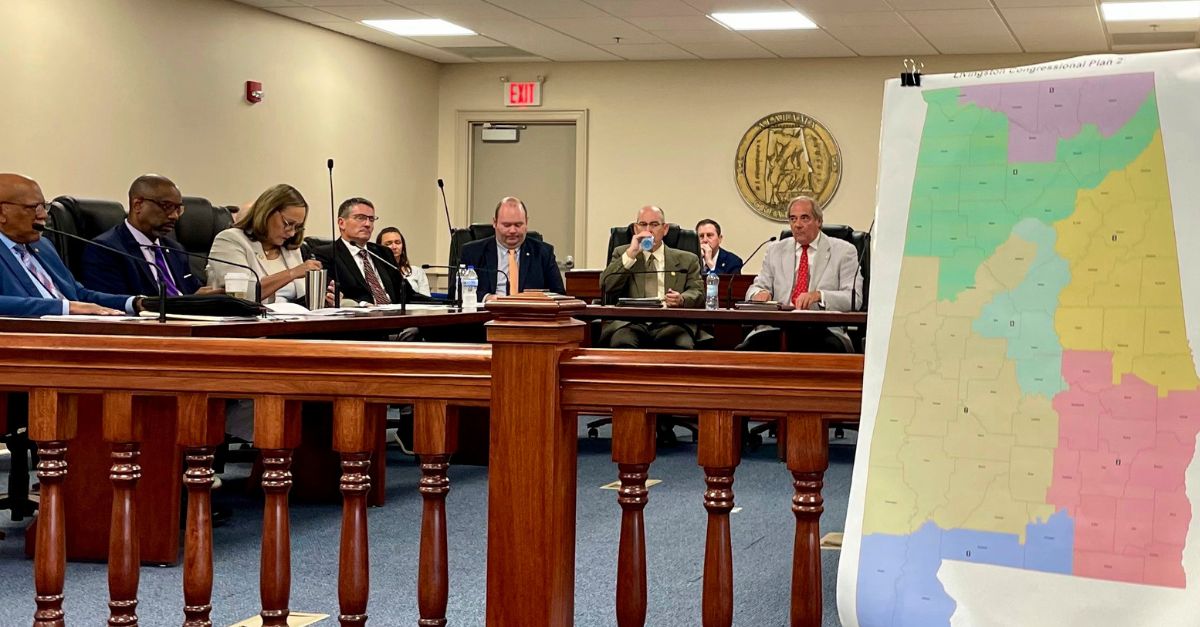 An Alabama Senate committee discusses the new congressional map Thursday, July 20, 2023, which ultimately was struck down for being in illegally gerrymandered just as was its predecessor. (AP Photo/Kim Chandler)
An Alabama Senate committee discusses the new congressional map Thursday, July 20, 2023, which ultimately was struck down for being in illegally gerrymandered just as was its predecessor. (AP Photo/Kim Chandler)
A panel of federal court judges appeared stunned by Alabama’s actions in the aftermath of its loss at the Supreme Court where the justices threw out its racially gerrymandered Congressional districting map which violated the Voting Rights Act (VRA).
Alabama was expected to draft and implement a new map that created increased opportunities for Black voters to elect candidates of their choosing, but it failed to do so. Instead, Alabama offered new arguments which fell flat with the court.
The litigation was the result of Alabama’s ongoing attempts to pack one-third of the state’s Black voters into a single congressional district while spreading the remaining Black voters across three congressional districts. The plan meant that only one of the state’s seven congressional districts had a chance of electing a Black representative, despite the state having a roughly 27% Black population.
In the Supreme Court’s June ruling striking down that map, Chief Justice John Roberts noted that Alabama’s political campaigns have been “characterized by overt or subtle racial appeals,” and that the state’s “extensive history of repugnant racial and voting-related discrimination is undeniable and well documented.”
The high court ruled 5-4 against Alabama’s redistricting plan over the dissents of Justices Clarence Thomas, Samuel Alito, and Amy Coney Barrett. The ruling affirmed the district court’s order that Alabama redraw its maps to include a second majority-Black district or “something quite close to it.”
The case next returned to the district court to manage the remedial phase of the case and Alabama’s submission of a new map that contained this “opportunity district.” However, what Alabama ultimately submitted had the same flaws as the map struck down by the Supreme Court, and admitted to the court that it did not create the majority-Black district as instructed.
The panel — made up of two Donald Trump appointees and one Bill Clinton appointee — said it was “deeply troubled” and “disturbed” by Alabama’s failure to submit a proper districting plan. Clinton appointee and U.S. Circuit Judge Stanley Marcus, who typically sits on the U.S. Court of Appeals for the 11th Circuit, joined Trump appointees U.S. District Judges Anna Manasco and Terry Moorer.
The panel delivered a unanimous per curiam opinion that slammed Alabama.
The state “ultimately did not even nurture the ambition to provide the required remedy,” it said.
It continued, putting Alabama’s failure to comply with court orders in a broader context:
And we are struck by the extraordinary circumstance we face. We are not aware of any other case in which a state legislature — faced with a federal court order declaring that its electoral plan unlawfully dilutes minority votes and requiring a plan that provides an additional opportunity district — responded with a plan that the state concedes does not provide that district. The law requires the creation of an additional district that affords Black Alabamians, like everyone else, a fair and reasonable opportunity to elect candidates of their choice. The 2023 Plan plainly fails to do so.
The map, whrly lacked the court-ordered remedy (and still contained only one majority-Black district), was signed into law by Gov. Ivey on the same day it was passed by the state legislature.
[callout-relatThroughoute of a voluminous 198-page ruling, the panel dissected Alabama’s arguments. Of particular note was the panel’s response to Alabama’s argument centered on the position of Supreme Court Justice Brett Kavanaugh.
Read Related Also: Delphi Murders: Prosecution Rejects ‘Grandstanding’ Defense Theory, Calls Pagan White Nationalists Claim a ‘Fanciful Defense’
Kavanaugh sided with the Court’s majority (and against Alabama) in Merrill v. Milligan, and authored a brief concurrence in which he wrote that the VRA “establishes an effects test, not an intent test.”
Alabama argued that the nuance raised in Kavanaugh’s concurrence supported its second map as-is. The panel, however, was unconvinced and wrote: “Justice Kavanaugh did not suggest, let alone say, that he ‘vote[d] to affirm’ despite finding that the Plaintiffs submitted no illustrative map that properly considered race.”
Alabama also tried another argument aimed directly at the conservative justices: that the Court’s recent ruling against affirmative action programs in college admissions meant a voting map that created a majority-Black district was also unconstitutional.
The justices ruled last June that race-conscious admissions programs at Harvard University and the University of North Carolina violate the Equal Protection Clause of the Fourteenth Amendment of the Constitution.
The panel rejected the voting-college admissions analogy out of hand, saying the college admissions litigation was “fundamentally unlike this case.” It continued, explaining the difference between providing minority voters an advantage and simply treating them fairly:
The Voting Rights Act does not provide a leg up for Black voters — it merely prevents them from being kept down with regard to what is arguably the most “fundamental political right,” in that it is “preservative of all rights” — the right to vote.
The panel also pointed out that it is not simply its opinion that race-based redistricting plans are legal; the Supreme Court itself said so in its ruling against Alabama. The panel quoted Roberts’ opinion:
But for the last four decades, this Court and the lower federal courts have repeatedly applied the effects test of § 2 as interpreted in Gingles and, under certain circumstances, have authorized race-based redistricting as a remedy for state districting maps that violate § 2. In light of that precedent . . . we are not persuaded by Alabama’s arguments that § 2 as interpreted in Gingles exceeds the remedial authority of Congress.
Republicans control all statewide offices in Alabama and six of the state’s seven congressional seats. Democratic Rep. Terri Sewell is Alabama’s first Black woman elected to Congress and Sewell currently represents the state’s single majority-Black district.
The panel also ruled that Alabama will not get a third chance to correct its districting map.
“[W]e have no reason to believe that allowing the Legislature still another opportunity to draw yet another map will yield a map that includes an additional opportunity district,” said the panel. Given Alabama’s failure to create an additional opportunity district as well as its statement to the court that it would be “practically impossible” for the legislature to create a new map before the 2024 elections, the court directed a Special Master and a cartographer to work on a new map.
You can read the full ruling here.
Have a tip we should know? [email protected]







